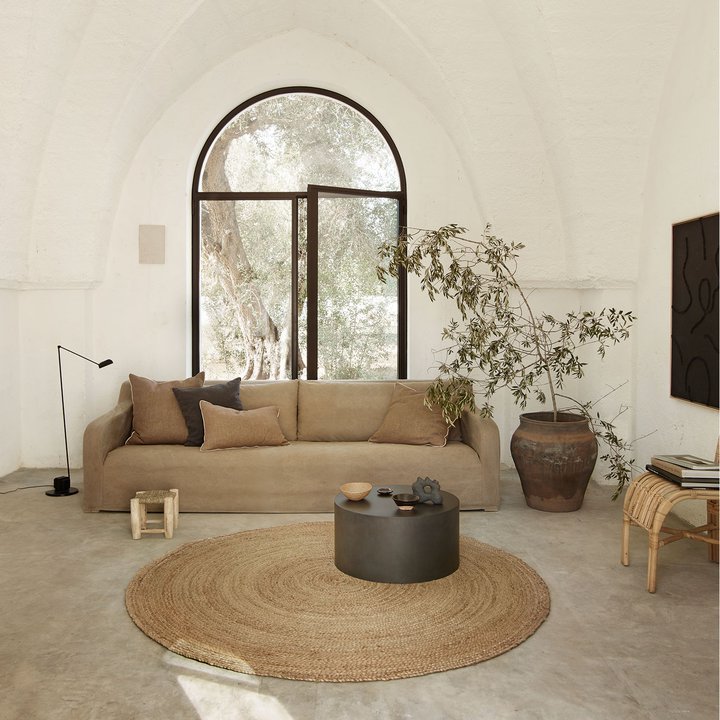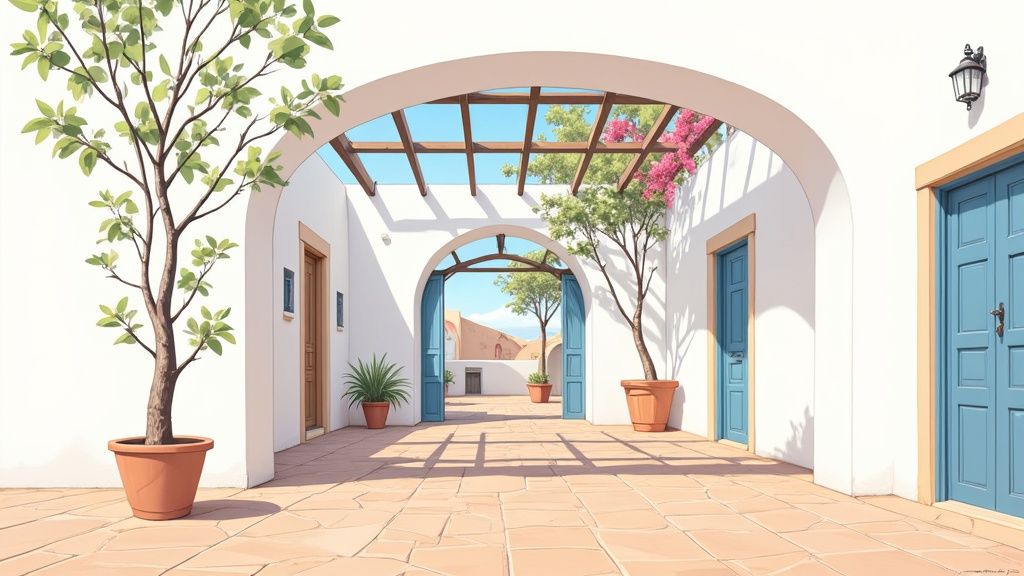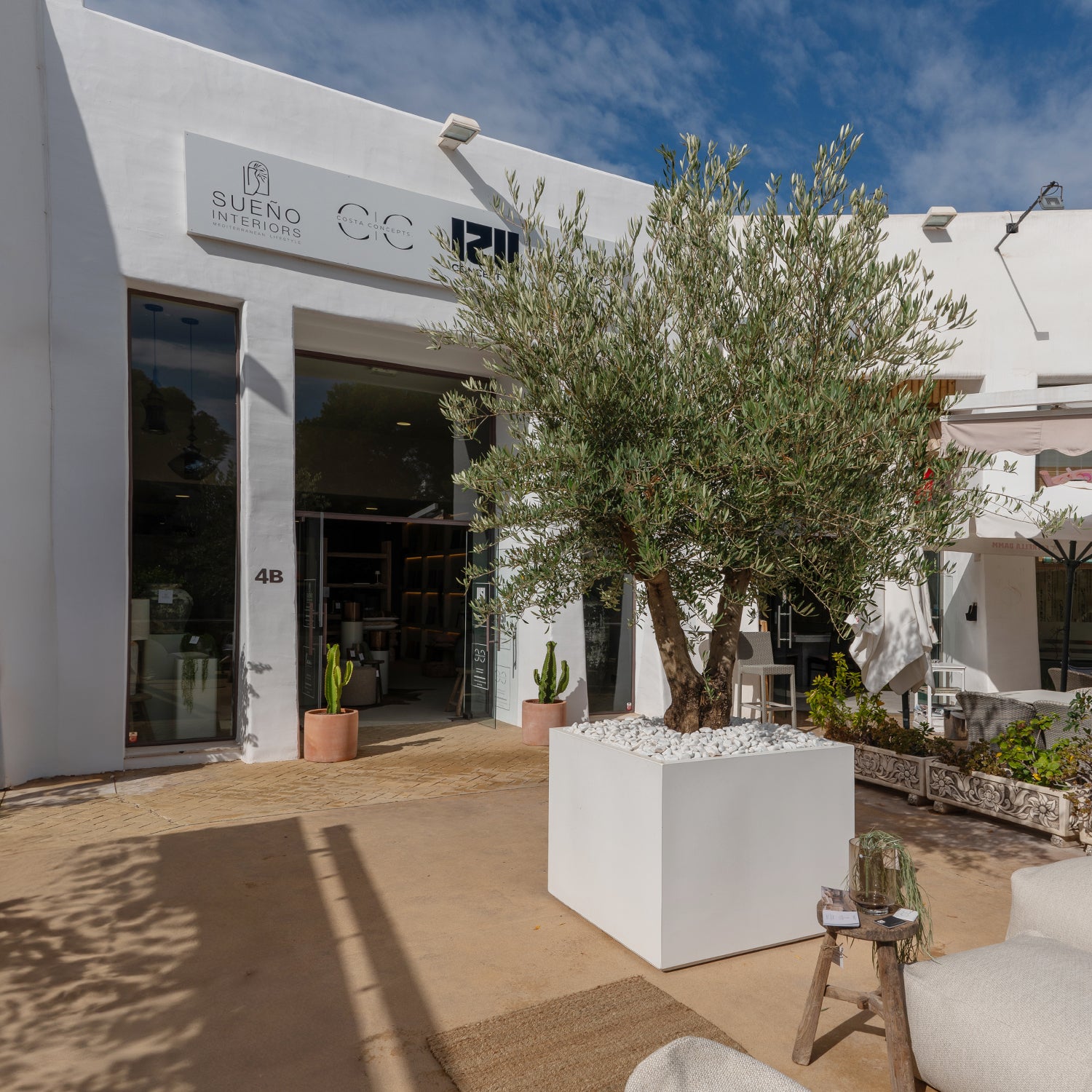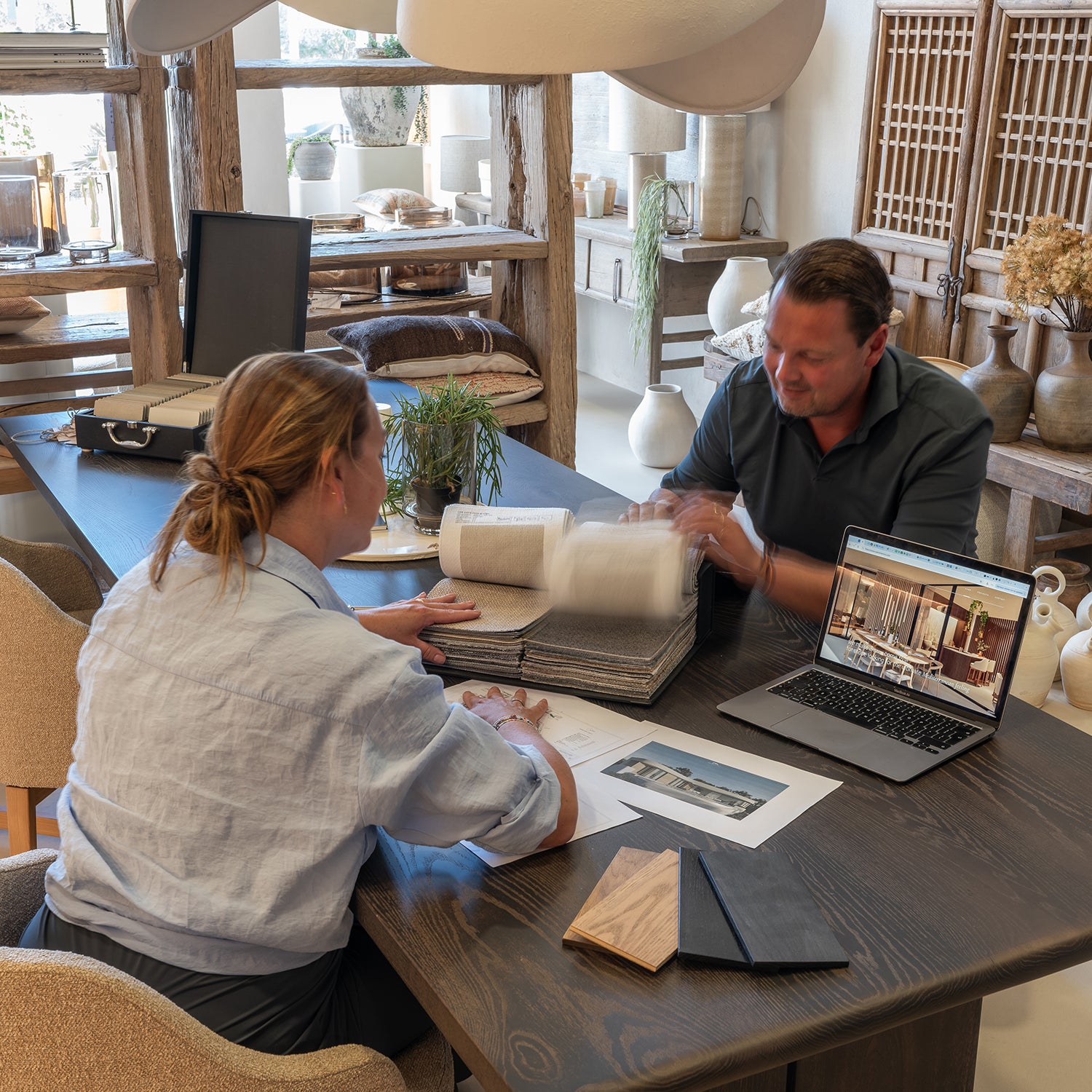Article: Mediterranean Interior Design Style Your Home
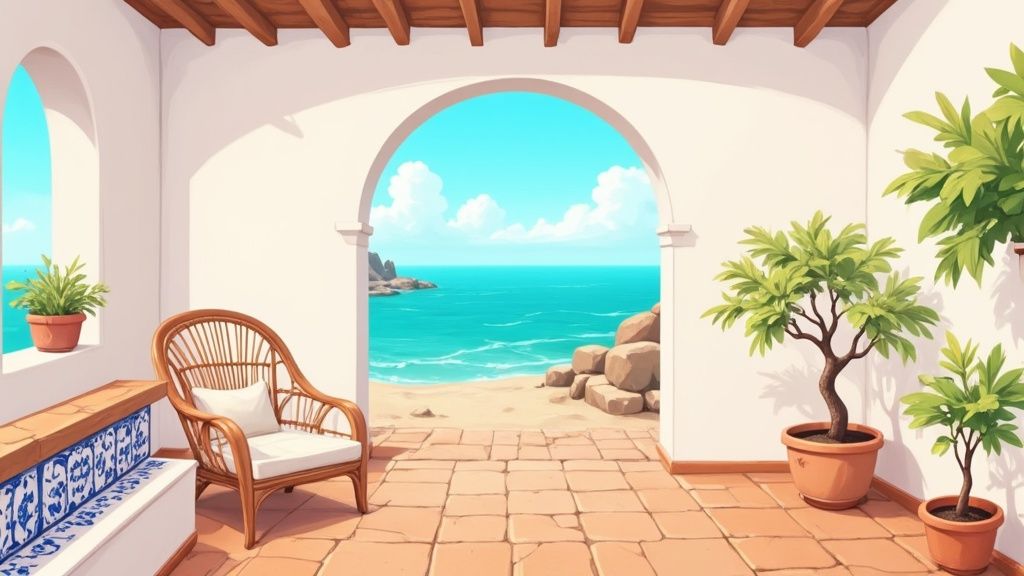
Mediterranean Interior Design Style Your Home
Picture yourself stepping into a home that feels like a sun-drenched villa on the coast—that’s the soul of Mediterranean interior design. It’s much more than just a look; it’s a way of living inspired by the coastal parts of Spain, Greece, and Italy. At its heart, this style is all about simplicity, indoor-outdoor living, and a deep, grounding connection to nature. To truly understand this aesthetic, visiting our studio in Moraira can provide a tangible experience of the textures and tones that define it.
Embracing The Spirit Of Coastal Living
Mediterranean design isn't about perfectly copying one single look, but rather about capturing a feeling. Think of it as bottling the warmth of the sun, the soft sea breeze, and the unhurried pace of life you find along Europe’s southern shores. It’s a design philosophy that grew organically from necessity and geography, shaped over centuries by the local climate and culture.
This style puts comfort and practicality first, creating spaces that feel both welcoming and effortlessly elegant. You'll notice a seamless flow between inside and out, made possible by large windows that flood rooms with natural light. The main idea is to craft a sanctuary that feels both earthy and airy—the perfect escape from the rush of modern life.
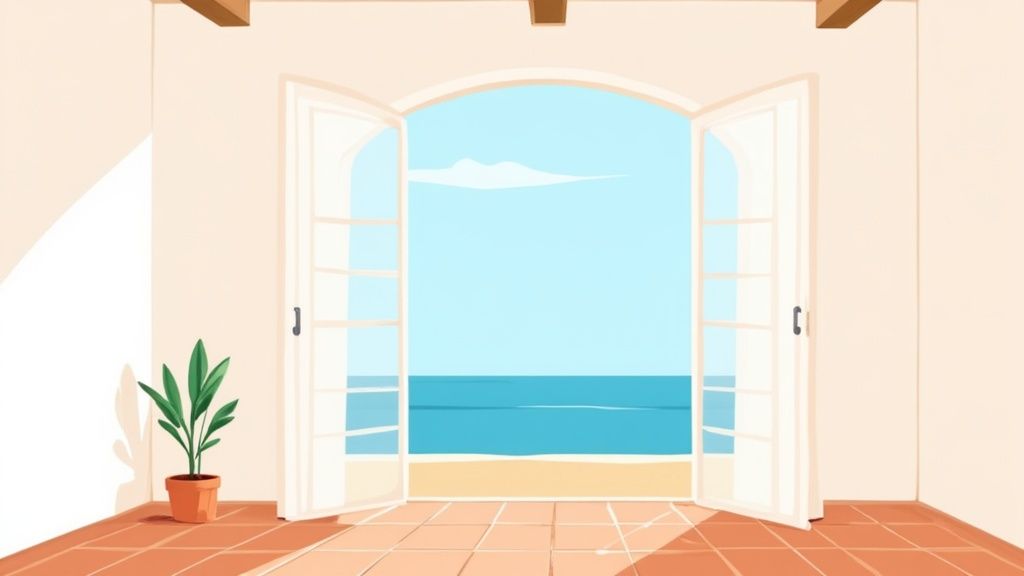
The Three Pillars Of Mediterranean Design
To really get a feel for this style, it helps to look at its three foundational principles. These pillars work in harmony to create that signature Mediterranean atmosphere you can almost taste.
- Connection to Nature: The design leans heavily on natural, locally sourced materials. Imagine textured plaster walls that beg to be touched, rustic exposed wooden beams overhead, and cool terracotta or stone floors underfoot. This creates a powerful link to the surrounding landscape.
- Emphasis on Light: Homes are built to welcome in as much sunlight as possible. Crisp white walls act as a brilliant canvas, bouncing light around the space and helping to keep interiors cool during those long, hot summers. Heavy drapes are often swapped for sheer curtains to let the breeze drift through.
- Rustic Simplicity: When it comes to furniture and décor, less is definitely more. Pieces are often crafted from solid wood, wrought iron, or woven materials, showing off their workmanship and a certain rustic charm. The real beauty is found in the imperfections and the stories each piece seems to tell.
While this article focuses on the Mediterranean style, understanding broader interior design principles can give you an even richer foundation for your creative journey.
The Mediterranean style is homey and approachable because it’s rustic and imperfect, but at the same time, it’s romantic, charming, and magical. It’s many things at once, which is why seeing Mediterranean-inspired interiors feels truly timeless.
Regional Variations And Influences
While they share common ground, the style has distinct regional flavours. A Greek island home, for instance, might feature stark white walls set against brilliant blue accents that mirror the sea and sky. A Spanish Finca, on the other hand, often pulls in warmer, earthier tones, intricate tilework, and robust, dark wood furniture. We invite you to explore these unique characteristics with our deeper look into the nuances of interior design in Spain.
Ultimately, Mediterranean interior design is about creating a home that encourages you to slow down, relax, and appreciate life’s simple beauties. To see how these principles come to life, we encourage you to start by visiting our studio in Moraira, where you can experience the textures and tones firsthand. It's the perfect first step in turning your home into a coastal haven.
The Core Materials of Mediterranean Design
If you really want to capture the soul of Mediterranean interior design, you have to start at its foundation: the raw, earthy materials that give it shape and substance. This isn't a style about perfection; it's tactile and grounded, celebrating the beauty found in natural imperfections. Think of it as creating a conversation between your home and the coastal landscapes that inspire it, using materials that tell a story of craftsmanship and time.
These elements aren’t just decorative afterthoughts. They’re deeply functional, born from a long history of building with whatever the land provided. Picture thick, textured plaster walls that seem to breathe, keeping rooms cool during those long, sun-drenched afternoons. Or the solid, reassuring presence of exposed wooden beams overhead, bringing a rustic warmth to a bright, airy space. These materials connect a home to its roots, making it feel authentic and built to last. A great way to appreciate these materials is by visiting our studio in Moraira, where you can see and touch them in person.
Embracing Earth and Wood
At its heart, a Mediterranean home is connected to the earth. The flooring is a perfect place to see this principle in action.
- Terracotta Tiles: These classic, sun-baked clay tiles are an absolute hallmark of the style. Their warm, reddish-brown tones instantly bring a sense of rustic charm, and they feel wonderfully cool underfoot—a very practical benefit in our climate.
- Natural Stone: Materials like travertine, limestone, or slate introduce organic texture and subtle shifts in colour. No two stones are ever the same, which adds a layer of history and permanence to floors, walls, or even a statement fireplace.
- Rustic Hardwood: In some variations, particularly those with a Spanish influence, you'll see dark or weathered hardwood floors. They provide a rich, grounding contrast to the typically light-coloured walls.
The real magic happens when these materials play off one another. A smooth, cool stone floor paired with the rough texture of a plaster wall creates a sensory experience that is both simple and deeply satisfying. This focus on natural, durable materials isn’t unique to the Mediterranean; you can find historical parallels across Europe. For instance, the Dutch Golden Age saw a similar appreciation for solid construction and natural materials, where stone and harmonious proportions became favoured architectural elements. You can discover more about this fascinating historical connection between design philosophies.
Building Texture and Character
Beyond the floors, texture is used generously throughout Mediterranean interiors to create visual depth and a sense of something handmade. This is where you can truly start to layer the style and give a room its own unique personality.
The beauty of Mediterranean materials is their honesty. A knot in a wooden beam or the uneven surface of a plaster wall isn't a flaw—it's a feature. It’s a testament to the natural origin of the material and the hand that shaped it.
Consider bringing in these key textural elements:
- Textured Walls: Forget perfectly smooth, flat walls. Techniques like stucco or limewash create a soft, matte finish with subtle variations in colour and texture. This effect catches the light beautifully, adding warmth and a sense of movement to the space.
- Wrought Iron: Used for light fittings, stair railings, or window grilles, wrought iron adds a touch of simple, handcrafted elegance. Its dark, sturdy form provides a striking contrast against white or neutral walls.
- Natural Fibres: Textiles made from linen, cotton, jute, and wool are essential for softening the hard surfaces of stone and wood. Think of breezy linen curtains, a chunky jute rug on the floor, or soft cotton throws tossed over a sofa.
By understanding the ‘why’ behind each material, you can begin to combine them with confidence. The goal is to create a space that feels like it has been collected over time, not just decorated in a day. To see these textures and materials up close, we invite you to start your journey by visiting our studio in Moraira. There, you can feel the coolness of authentic tiles and see how light plays on textured walls, bringing your Mediterranean vision one step closer to reality.
Mastering the Mediterranean Colour Palette
Colour is the very soul of Mediterranean interior design. It's about so much more than just picking a shade of paint; it’s about capturing the unique quality of the light and the natural landscape that defines the region. Think of your home as a blank canvas, where you'll learn to paint with the sun, sea, and earth to craft a space that feels both serene and brimming with life.
The whole aesthetic is built on a foundation of crisp, sun-bleached whites. This isn't just a stylistic whim—it's a practical tradition born from the very real need to reflect the intense summer sun and keep interiors cool. White walls act like a mirror, bouncing natural light around the room and making even the smallest of spaces feel open, airy, and expansive.
But white is just the beginning. It creates the perfect backdrop for the warmer, earthier neutrals that truly ground the palette. For real-life examples and palette inspiration, visiting our studio in Moraira is an invaluable step.
Building on an Earthy Foundation
Imagine taking a slow walk along a coastal path. The colours you see underfoot and in the distance are the very ones you'll want to bring inside. These are the grounding tones that add warmth and texture, stopping the white from feeling too clinical or stark.
- Sandy Beige: This is the colour of warm beaches, a soft neutral that adds a gentle, welcoming feel to any room.
- Terracotta: This rich, sun-baked clay tone is a direct nod to the classic tiles and pottery of the region, infusing a space with rustic and authentic warmth.
- Ochre: A deep, earthy yellow that evokes the colour of sunlit cliffs and dry fields, it brings a gorgeous touch of golden warmth.
These neutrals work in harmony to create a soothing, organic base. This is perfectly illustrated by the core materials that define the style—plaster, wood, and stone—which naturally carry these beautiful hues.

As the infographic shows, these fundamental materials inherently bring the foundational colour palette into the design, creating a look that feels seamless and natural. Once this neutral canvas is set, it's time to layer in the vibrant accents that give Mediterranean design its unforgettable character.
Weaving in Vibrant Coastal Accents
This is where the personality of your space truly comes alive. The secret is balance; using that neutral backdrop allows bolder colours to pop without overwhelming the room. Think of them as the perfect exclamation points in your design story.
The Mediterranean colour palette is often defined by the natural world, drawing inspiration from the sea, sky, and plant life. Here's a quick look at the key colours and what they represent.
Key Color Palettes in Mediterranean Design
| Color | Inspiration | Common Application |
|---|---|---|
| Crisp White | Sun-bleached village walls, seafoam | Walls, ceilings, linen textiles, furniture |
| Terracotta & Ochre | Sun-baked earth, clay pottery, cliffs | Floor tiles, pots, accent walls, textiles |
| Sandy Beige | Coastal beaches, natural stone | Walls, upholstery, natural fibre rugs |
| Cobalt & Cerulean Blue | The Aegean Sea, clear skies | Doors, window shutters, decorative tiles, textiles |
| Olive & Sage Green | Olive groves, hardy coastal plants | Cabinetry, textiles, potted plants, shutters |
By thoughtfully combining these colours, you can create a space that feels both authentic and deeply personal.
So, how do you use them? Consider these signature accent colours:
- Cobalt and Cerulean Blue: These are the iconic blues of the Aegean Sea and the sky on a perfect day. Use them for window shutters, a statement front door, decorative tiles, or in textiles like cushions and throws.
- Olive and Sage Green: Reflecting the sprawling olive groves, these muted greens add a soft, natural element that is both calming and sophisticated. They work beautifully for cabinetry, textiles, or simply through an abundance of live plants.
Once you’ve chosen your palette, the next step is bringing it to life. Mastering the practical techniques is crucial, and this resource on how to paint interior walls offers brilliant guidance for getting a professional finish.
Accessorising is another fantastic way to introduce these hues. You can learn more about selecting the right decor by exploring our guide to Spanish home accessories. By carefully balancing a neutral foundation with vibrant, nature-inspired accents, you’ll create a dynamic yet harmonious space that truly sings.
How to Furnish Your Mediterranean Home
Furnishing a Mediterranean home is all about striking a beautiful balance between substance and serenity. The aim isn't just to fill a space; it's to choose pieces that feel grounded, comfortable, and deeply connected to nature. What you end up with is an atmosphere that feels both substantial and wonderfully relaxed.
The idea is to find functionality wrapped in natural beauty. Think of solid wood furniture with rustic or weathered finishes that seem to tell a story of time and use. These pieces should feel robust and timeless, not overly ornate or delicate. Their character shines through in the grain of the wood, the handcrafted details, and the sense of permanence they bring to a room.
This focus on durable, character-rich furniture is central to the authentic mediterranean interior design style. It’s about creating a space that feels lived-in and loved from the very first day.
Selecting Your Key Furniture Pieces
When you’re choosing the main furniture for your living and dining rooms, put natural materials and simple, strong silhouettes at the top of your list. These items are the backbone of your design, so they need to be both beautiful and built to last.
- Solid Wood: Look for tables, cabinets, and bed frames made from woods like pine, walnut, or olive. A distressed or reclaimed finish adds a layer of rustic charm that feels perfectly at home in a coastal setting.
- Wrought Iron Accents: Simple, elegant wrought iron can be introduced through coffee table bases, bed frames, or light fixtures. Its dark, slender form creates a beautiful contrast to lighter walls and soft textiles.
- Woven Textures: Rattan, wicker, and seagrass are essential for adding a touch of casual, breezy elegance. Consider these materials for armchairs, side tables, or decorative baskets to introduce texture and a connection to the outdoors.
The mantra for Mediterranean furnishing is 'less is more, but with character'. Each piece should not only serve a function but also contribute a unique story to the room, whether through its weathered finish, handcrafted origin, or natural material.
The Role of Soft Furnishings and Textiles
While furniture provides the structure, it’s the textiles that bring softness, comfort, and movement into the space. They’re crucial for making the most of natural light and creating an inviting, touchable environment. The key here is to choose fabrics that feel light, airy, and natural.
Breezy linen and soft cotton are the go-to choices. Sheer curtains are a hallmark of the style, letting sunlight filter through gently while still offering a sense of privacy. They billow softly in the breeze from an open window, perfectly capturing that vital indoor-outdoor connection.
For upholstery, stick to neutral tones like white, beige, or soft grey to keep things feeling bright and open. You can then bring in pops of colour with cushions, throws, and rugs in shades of sea blue, olive green, or terracotta.
Curating Your Accessories and Décor
Accessories are the final layer that transforms a house into a home. In Mediterranean design, these finishing touches should feel curated yet effortlessly placed, as if collected over years of travel and life. The focus stays firmly on natural, artisanal objects.
- Hand-Painted Ceramics: Vases, bowls, and decorative plates with traditional patterns add a splash of colour and craftsmanship.
- Rustic Pottery: Unglazed terracotta pots and urns are perfect for both indoor and outdoor spaces, reinforcing that connection to the earth.
- Abundant Greenery: No Mediterranean home is complete without plenty of indoor plants. Olive trees, ferns, and succulents in terracotta pots bring life, colour, and fresh air into the space.
This appreciation for natural materials and functional aesthetics is a growing trend. In fact, the Netherlands' interior design market, valued at USD 1,261.47 million in 2023, is seeing significant growth driven by a demand for sustainable and natural interiors. The core principles of Mediterranean design align perfectly with this movement, making it increasingly relevant for modern homes. You can explore more about these market trends and their drivers.
Ultimately, furnishing your Mediterranean home is about creating a personal sanctuary. To truly understand how these elements come together, we invite you to visit our studio in Moraira. There, you can see and feel the quality of the materials and get expert advice on selecting the perfect pieces to bring your vision to life.
The Art of Tiles in Mediterranean Design
In Mediterranean interior design, decorative tiles are so much more than just a floor covering. They’re a vibrant art form, a signature feature that tells a story of culture, craftsmanship, and history that has been centuries in the making. From the sun-drenched coasts of Spain and Portugal to the traditional homes of the Netherlands, ceramic art has long been the secret to turning everyday spaces into stunning visual statements.
Tiles are where this design style truly lets its personality shine. Picture the cool feel of intricately patterned tiles under your feet on a warm day, or a kitchen backsplash that bursts with life and colour. It’s in these moments that the true spirit of Mediterranean living is captured, blending practicality with a beauty that’s impossible to ignore.
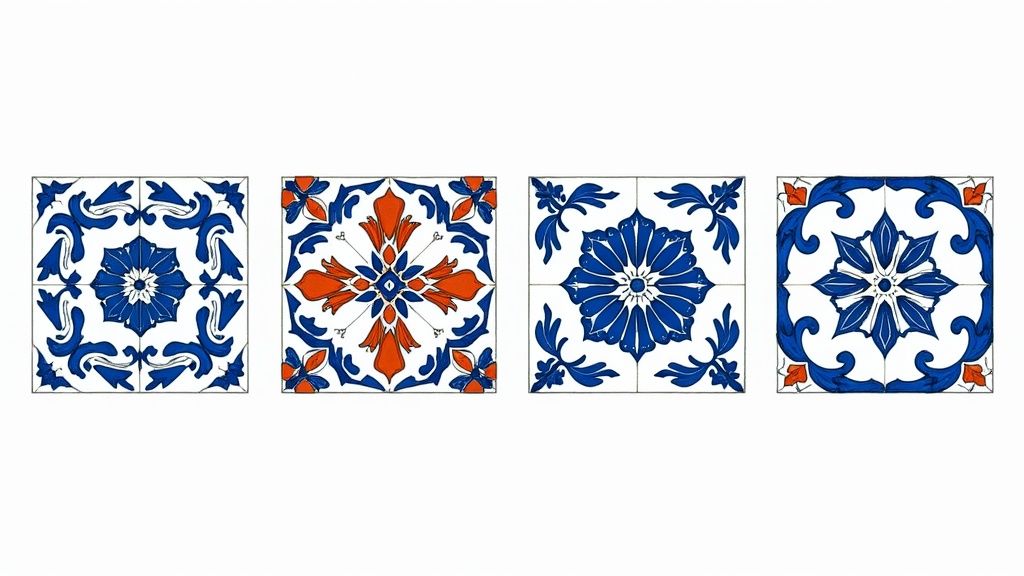
Vibrant Iberian Influences
When you think of Mediterranean tiles, your mind likely travels to Spain and Portugal, home of the famous Azulejos. These glazed, tin-fired ceramic tiles are world-renowned for their bold geometric patterns and vivid narrative scenes.
In Spanish design, you'll find them used to great effect in a few key areas:
- Floors: Creating a durable and decorative "rug" effect in entryways, kitchens, and courtyards.
- Kitchen Backsplashes: Adding a splash of personality and an easy-to-clean surface behind the hob.
- Statement Walls: Turning a simple wall in a bathroom or living area into a breathtaking work of art.
These tiles aren’t just decorative afterthoughts; they are a deep-rooted part of the architectural identity, bringing an incredible energy and character to spaces both inside and out.
A Surprising Northern Connection
What’s really fascinating is that this passion for decorative tiling isn't just a southern European affair. A surprising parallel can be found in historic Dutch interiors, which show a shared love for turning functional surfaces into art. Historical Dutch interiors exhibit significant use of decorative tiles, a feature central to Mediterranean interior design, known for its rich colours and textures, indicative of cultural exchange and stylistic adoption. Back in the 17th and 18th centuries, Dutch homes often featured enamelled earthenware tiles, which frequently covered entire fireplace areas and surrounding walls. These blue and white tiles perfectly combined utility with a vibrant aesthetic appeal. You can read more about the history of Dutch decorative tiling.
This shared heritage shows how the desire to blend beauty with everyday function transcends geography. Whether it's a Spanish courtyard or a Dutch hearth, the tile is a canvas for cultural expression.
Incorporating Tile into Your Home
Bringing this timeless element into your own space opens up a world of creative possibilities. You don't need to tile an entire room from floor to ceiling to make an impact. Sometimes, starting with smaller, more targeted applications is the best way to introduce pattern and colour.
For a classic look, a blue-and-white motif is always a winning choice, whether it’s a Delft-inspired floral or a geometric Moorish pattern. If you’re after a warmer, more rustic feel, terracotta tiles with hand-painted details can add immense charm. The key is to see tiles not just as a surface, but as an opportunity to add a layer of personality that is both incredibly durable and beautiful.
To see how these stunning tiles can be integrated into a complete design, we warmly invite you to visit our studio in Moraira. There, you can explore a curated selection of authentic tiles and get inspired by how they can transform your home.
Bring Your Mediterranean Vision to Life in Moraira
It’s one thing to read about the sun-drenched colours and earthy materials of Mediterranean design. It’s another thing entirely to experience it. Moving from inspiration to reality is the most exciting part of the journey, where you get to transform those beautiful ideas into a space that is completely your own.
This is where the real magic happens. We invite you to step away from the screen and into our world by visiting our interior design studio in Moraira. Think of it less as a showroom and more as a creative playground, designed to let you see, touch, and truly feel the soul of Mediterranean living.
Experience the Materials Firsthand
Here, you can run your hand over the cool, textured finish of authentic stone or feel the rich grain of rustic, reclaimed woods. See for yourself how the natural light plays across different plaster finishes, or compare the soft, breezy feel of linen against the sturdy weave of a natural fibre rug.
It's an experience that photos and descriptions just can't replicate.
The true essence of Mediterranean design is tactile. It’s a style meant to be lived in and felt, where the beautiful imperfections of natural materials tell a story of authenticity and warmth.
Seeing these elements in person helps build the confidence you need to make the right choices for your home. You’ll get to appreciate the subtle variations in colour and texture that give each piece its unique character. Our studio brings the best of this style together, all under one roof. The best way to begin is by visiting our studio in Moraira.
From Vision to a Bespoke Plan
As you explore, our designers are on hand for a friendly, personalised chat. We know that every home—and every homeowner—is unique. Our job is to help you translate your ideas, whether it's a saved image or just a feeling you want to create, into a solid, actionable plan.
We’ll guide you through sourcing the perfect elements, from a single statement piece of furniture to a complete interior scheme. We can help you craft a bespoke design that truly captures coastal living, tailored perfectly to your lifestyle and space.
If you’re planning something bigger, our expertise extends to full-scale transformations. You can get a feel for how we handle these projects by reading our guide to a complete house reform in Moraira.
Your home’s transformation from a dream to a beautifully designed reality starts with that first step. Let us help you create a space that isn't just seen, but deeply felt—a true sanctuary that embodies the relaxed elegance of the Mediterranean.
Got Questions? Let's Talk Specifics
Bringing the Mediterranean look into your home is exciting, but it often comes with a few practical questions. It’s a beautifully flexible style, but knowing how to adapt it for different climates, spaces, and budgets is what makes a house feel like an authentic, personal home. Let's walk through some of the common things people ask. For personalized advice, we always recommend visiting our studio in Moraira.
Can Mediterranean Style Work in Colder, Darker Climates?
One of the biggest questions we get is whether this sun-drenched style can translate to a place with less natural light. The answer is a definite yes, but it requires a few clever tweaks.
While a traditional Greek island home uses brilliant white walls to bounce back the intense sun, that same white can look cold and sterile in a cloudier climate. Instead, lean into warmer off-whites, creamy beiges, or even a very light, dusty terracotta. These colours create a cosy, inviting glow without feeling stark.
The other key is to make the most of the light you do have. Swap heavy drapes for sheer, breezy curtains that let light filter through. A few well-placed mirrors can also work wonders, bouncing light around the room and making it feel brighter.
Adapting to Different Budgets and Spaces
Another common concern is the cost. Do you need to import expensive materials to get the look? Not at all. The real spirit of this style is found in rustic simplicity, not over-the-top luxury.
- Flooring: If authentic terracotta or stone tiles aren't in the budget, you can find incredible high-quality ceramic or porcelain tiles with a terracotta-look finish. They offer the same warm, earthy feel and are both durable and cost-effective.
- Walls: You don't need a plasterer to get that textured wall effect. Certain painting techniques or even textured wallpapers can mimic the look for a fraction of the cost of traditional stucco.
- Furniture: This is where you can have some fun with second-hand finds. A wooden table or cabinet with a few scuffs or a weathered patina fits the aesthetic perfectly and often costs far less than buying new.
What about smaller spaces? The Mediterranean ethos is all about open, airy rooms, so the trick is to avoid clutter. Choose fewer, more impactful pieces. A single rustic wooden console and a comfortable linen sofa will do more for the style than a room packed with small, disconnected items. Stick to that light colour palette, and the space will feel much larger and more open than it is.
The true essence of Mediterranean design isn't about lavish spending. It’s about celebrating natural materials, embracing imperfection, and creating a comfortable, lived-in atmosphere that feels connected to nature.
Finally, people often ask how to modernise the style without losing its soul. A great source of inspiration is the "Nancy Meyers aesthetic" you see in many popular films. It perfectly captures a modern Mediterranean feel by blending classic elements—like linen upholstery, neutral palettes, and natural light—with clean lines and comfortable, contemporary furniture.
It feels timeless because it avoids being a historical recreation. Instead, it focuses on creating a relaxed yet elevated atmosphere. This approach shows that Mediterranean interior design isn't a relic of the past, but a living, breathing style that adapts beautifully to modern life.
Ready to stop dreaming and start designing? At Sueño Interiors, we translate the ideals of coastal living into beautiful, practical interiors for your home. Visit our studio in Moraira to experience the materials, feel the textures, and begin creating your own Mediterranean sanctuary.

